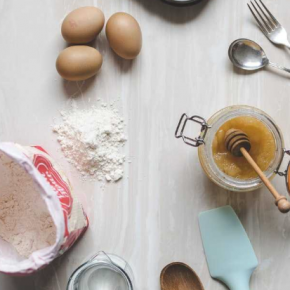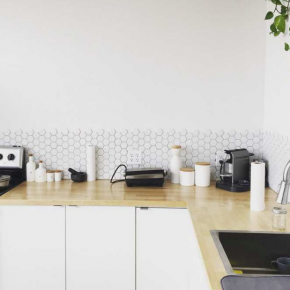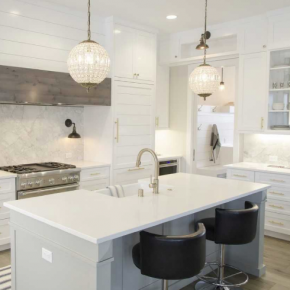
GUEST ARTICLE: Why you should choose laminate for your kitchen worktops
In this article, the benefits of using Laminate for kitchen worktops are tabled, as how the surface has come on in leap and bounds in recent years and offers excellent value for money, minimal maintenance and stylish good looks is referred to.
One of the best things about having laminate worktops is the massive variety of colours and finishes that are available, easily allowing you to stamp your personality on your new kitchen and make your surfaces sing. It also wins by being hard wearing, easy to clean and scratch resistant and substantially cheaper than natural surfaces like granite.
Laminate, sometimes referred to as Formica, is made from layers of resin-coated paper sandwiched together under high heat and pressure. The top layer, coloured and/or patterned, is covered with hard plastic. Handily, it can be shaped under heat and pressure, e.g. to create rounded edged worktops.
These worktops make incredibly realistic and durable substitutes for much more expensive surfaces, such as granite, marble, stone, quartz or wood. Your laminate surface can accurately mimic lots of different surfaces, including oak, walnut, cherry wood or pine; blue limestone, white quartz or black granite. It is often impossible to tell the difference between a laminate surface and the real thing.
Colours on offer range from cream to shocking pink, lime and jet black while patterns include metallic flecks, crystals and geometric shapes. You can order matching splashbacks or kickboards or choose contrasting shades for a pop of colour.
Choosing your laminate worktop
• Test samples in your kitchen: Once you have decided to go with laminate, collect a few samples from a speciality kitchen shop or order some online, and test them out at home. It is best to use a thicker, high pressure laminate, not a cheap quality one, which will mark, scorch and wear more rapidly.
You can check a laminate’s quality by vigorously rubbing a two-pence piece on the surface. If it’s decent quality, the surface won’t mark.
Choose a variety of different colours, patterns and finishes and have a look how different samples look against your walls, cabinetry and floors. Think about the appliances they will be matched with too. It’s a good idea to look at the samples in the daylight and in the evening.
• Think about wear and tear: Despite being incredibly hard-wearing, laminate – like any other surface – can show up scratches, especially because kitchen worktops tend to get a lot of wear.
As scratches tend to be light coloured, they will be more obvious on dark surfaces. If you are keen to have a dark surface in your kitchen you could chose a pattern that makes marks less visible.
Remember too that a glossy surface will show up scratches more clearly and be dulled by use faster than a matte finish. To carry out your scratch test take a sharp knife, such as a steak knife, and a pizza cutter and drag them across the sample.
• Cleaning and maintenance: Laminate has an important advantage over many other surfaces because it is very easy to clean and keep looking fresh with a cheap household cleaner and a cloth. Compare this to wooden worktops, where the surface’s natural grain can trap dirt and germs if left to fester. Wooden surfaces also need sanding and oiling twice a year to keep them looking good, while natural stone surfaces can chip. What’s more, wood and granite can stain, particularly when exposed to an acid liquid such as red wine.
If a section of your laminate worktop does get badly damaged, it is relatively easy and cheap to replace a section.
Consider going for splashbacks formed from a single piece of laminate with a rounded edge in front to prevent nasty spills going down the back of your cabinet, and eliminate corners and seams that can trap dirt and be difficult to clean.
While wooden edges might look great, they are more likely to show wear and tear after absorbing moisture. You will need to touch them up periodically to keep them looking good.
• Ease of installation: Laminate is one of the rare surfaces that lends itself to a bit of DIY installation. Meanwhile, quartz, granite and composite stone can all be very heavy and need professional templating and cutting, so that reinforced cabinetry and specialist installation are needed. Laminate is relatively easy to work with under pressure and to cut and mould.
Although laminate has many advantages, it is not perfect and you will still need to take care of it. Laminate can burn, and even though they say it’s as heat resistant as quartz, it’s best not to put a hot pan directly onto it; use a trivet instead.
Laminate is as scratch resistant as granite, but it is still recommended that you use a chopping board when you’re cutting food, just to be on the safe side. Scratches will be particularly noticeable if your kitchen surfaces are high gloss.
Although laminate is not porous, the join around the sink can be vulnerable to swelling. It won’t be the laminate but the chipboard or timber under it that will soak the water up if left for more than ten minutes. Wipe up spills straight away.
Latest news

4th March 2025
Gilberts Proves How to Balance Cost-Effective Restoration
Hidden talents have been revealed in the renovation of an iconic 1930s art deco building to transform it into a modern entertainment venue – and Gilberts Blackpool ventilation features there…
Posted in Air Conditioning, Articles, Building Industry News, Building Products & Structures, Building Services, Case Studies, Facility Management & Building Services, Heating, Ventilation and Air Conditioning - HVAC, Restoration & Refurbishment, Retrofit & Renovation
4th March 2025
S. Norton Group showcases £20m shredder for metals recycling CEOs
S. Norton Group hosted a tour of its latest £20m investment in state-of-the-art shredder technology for 17 senior leaders in the European metals recycling industry.
Posted in Articles, Building Industry News, Building Products & Structures, Building Services, Case Studies, Facility Management & Building Services, Plant, Equipment and Hire, Posts, Site Preparation, Sustainability & Energy Efficiency, Waste Management & Recycling
28th February 2025
Passivent ventilation solutions are top of the class
Passivent has supplied a combination of Hybrid Plus2 Aircool ventilators and Hybrid Plus Airstract roof ventilation terminals for a new London primary school.
Posted in Air Conditioning, Articles, Building Industry News, Building Products & Structures, Building Services, Case Studies, Ceilings, Facility Management & Building Services, Heating, Ventilation and Air Conditioning - HVAC, Restoration & Refurbishment, Retrofit & Renovation, Roofs, Sustainability & Energy Efficiency, Ventilation, Walls
28th February 2025
Troldtekt: New acoustic liner ensures good acoustics and easy handling
Both a building’s users and its developers have a good reason to get excited about the new Troldtekt Plus 25 panels. This specially developed acoustic panel sets a high standard for both sound absorption and building efficiency.
Posted in Acoustics, Noise & Vibration Control, Articles, Building Industry News, Building Products & Structures, Building Services, Building Systems, Ceilings, Facility Management & Building Services, Floors, Innovations & New Products, Insulation, Interior Design & Construction, Interiors, Restoration & Refurbishment, Retrofit & Renovation, Timber Buildings and Timber Products, Walls
 Sign up:
Sign up: 
